The Roles & Structure of Teeth
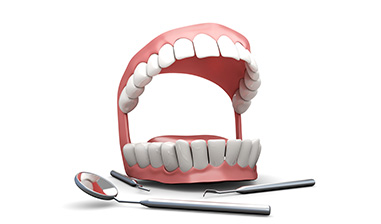
words”, and “shaping the face”.
POINTS TO NOTE
- Permanent teeth are the teeth you use for your entire life. Please take good care of your teeth
by understanding their roles.
Structure and the Functions of the Teeth
A tooth that is visible in your mouth is only a part of the entire tooth. The root of the tooth is completely buried into the jaw bone.
Structure of the Tooth
A tooth consists of enamel, dentin, cementum and pulp tissue. The portion of a tooth exposed to the oral cavity is known as the dental crown, and the portion below the dental crown is known as the tooth root. The dental pulp cavity exists in the center of the tooth, through which the dental pulp, called the nerve, runs. In order to receive an impact on the tooth and to absorb and alleviate the force on the jaw, the surface of the tooth root area (cementum) and the alveolar bone are connected by a fibrous tissue called the periodontal ligament. The tooth is supported by the tissue consisting of the alveolar bone, gums and the periodontal ligament.
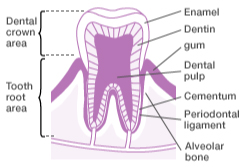
- Enamel : The hardest bodily tissue covering the surface of the dental crown. It is as hard as crystal (7 on the Mohs scale of mineral hardness).
- Dentin : The tissue that forms the tooth from the dental crown to the tooth root, situated inside the enamel and cementum. It is softer than the enamel. A small tube filled with tissue fluid, called the dentinal tubule, runs inside the dentin.
- Cementum : The tissue covering the surface of the tooth root. It connects the alveolar bone with the tooth by the periodontal ligament. Its hardness is similar to bone.
- Dental pulp : The tissue is called the nerve. Blood vessels and the lymph vessels, as well as nerve fibers, are located in the dental pulp, supplying nutrients to the dentin.
- Periodontal : Tissue consisting mainly of the fibrous tissue that connects the tooth root and the alveolar bone. It prevents force applied to the tooth from being directly imposed on the alveolar bone while chewing food.
- Alveolar bone : The jaw bone supporting the tooth; the tooth is planted into this bone. When a large part of the alveolar bone is destroyed by periodontal disease or other causes, the tooth becomes loose.
- Gingiva : The soft tissue covering the alveolar bone. It is generally called “gum”.
- Gingival sulcus : The small space between the tooth and the gums. Even people with healthy teeth usually have a depth of 1 to 2 mm in this space. When this space deepens due to inflammation, it is called the periodontal pocket or gingival pocket.
Names of the Teeth
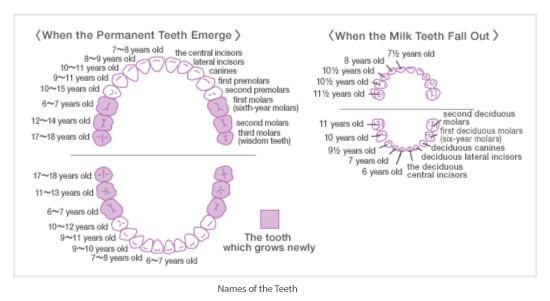
Canine Teeth
The canines are the third permanent teeth from the center of the mouth to the back in the upper and lower jaws. There are a total of 4 canines, two in the upper jaw and two in the lower.
They are used to tear food.
Molars
The teeth located behind the canines grind food like a mill. In milk teeth, there are two molars, each on the left and right sides of the upper and lower jaws. In permanent teeth, there are two premolars and molars each on the left and right sides of the upper and lower jaws, for a total of 16 molar teeth
(20 when counting the wisdom teeth).
“How many teeth do we need to chew food?”
According to a report on the results of research regarding the current number of remaining teeth in elderly people and their chewing abilities, it has become clear that if a person has roughly 20 or more teeth, they can chew most types of food.
In order to maintain 20 or more teeth, even at an older age, it is recommended that appropriate plaque control be performed on a daily basis, in addition to receiving regular checkups in order to detect symptoms early and to receive prompt treatment. Even if you do not have 20 teeth currently, you can regain your chewing ability using dental prostheses. So, please take good care of your remaining teeth.
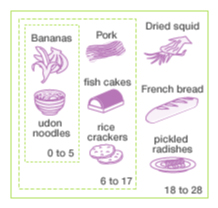
The Number of teeth Necessary for Chewing
From Shijo et al: “Handbook for Persons in Charge of Dental Education and Dental Health Consultation Based on the Law of the Health and Medical Services for the Aged”
Milk Teeth and Permanent Teeth
With the growth of the body, the jaw grows bigger. As the jaw grows, children’s teeth, or “milk teeth” are replaced by adult teeth known as “permanent teeth”. When all of a child`s permanent teeth have emerged,the chewing force becomes stronger, enabling them to eat various types of food easily. Permanent teeth are very important teeth, which a person uses for the entire course of their life.
Differences between Milk Teeth and Permanent Teeth
- Color : Milk teeth are almost white, and permanent teeth have a yellow-tinge.
- Size : Milk teeth are a size smaller than permanent teeth.
- Teeth Quality : Both enamel and dentin are thinner in milk teeth; therefore, caries in milk teeth progress more quickly.
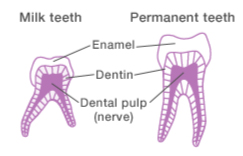
The Mechanism and Timing of Transition from Milk Teeth to Permanent Teeth
Human teeth only transition from milk teeth to permanent teeth once. All of the milk teeth emerge at an age from two to three; however, since the jaw bone continues to grow, the sizes of the teeth and the jaw gradually become imbalanced. When the cells that break down the tissue appear around the roots of the milk teeth, the roots gradually dissolve and are absorbed,becoming shorter in height.
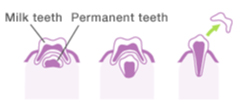
When the permanent teeth become large enough, the milk teeth naturally start to fall out. By about age 12, all of the milk teeth are replaced by 28 permanent teeth.





